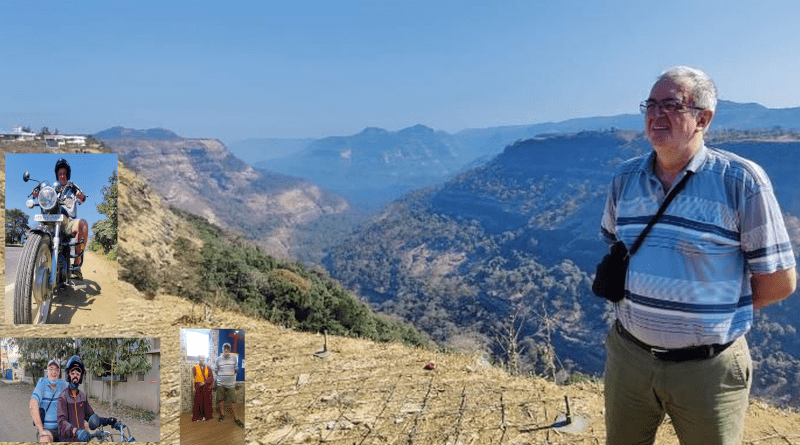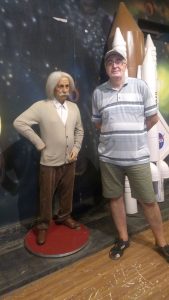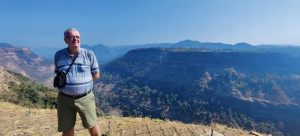Introspicere – India By An Expatriate Professor: Bosnian And Herzegovinian, Easy Rider In India – Essay
By Prof. Dr. Sabahudin Hadzialic
Indeed, when can one finish touring the city and its surroundings? A city 30 kilometers wide, both from North to South and from East to West. Ten million people, a meeting place of ancient India and postmodern trends. For your reporter, the city of Pune is only somewhere at the beginning, even after the reports you have read in last months. I wanted to visit the center and the suburbs in one day. Visit Camp Pune and visit the Sunil Wax Museum some 75 kilometers from the center, far outside the city limits. I even managed to go further from the area of Lonavala (about 60,000 inhabitants), within which the Museum is located, all the way to their Canyon Valley, located between Lonavala and Khandala (mountain station, 3 kilometers away from Lonavale), standing just a few meters from the edge of the abyss more than 400 meters deep.
The hustle and bustle of London, Warsaw and Vilnius: three in one
Since I belong to those who never give up factual, argumentative and objective journalism, I never want to write about something I have not personally experienced. I can talk about what I “heard” in the bar, but never in the text. “Hear” and see are minus and plus, two diametrically opposed views. Why? Because what we “hear” about something, gain extra strength by imagining of inner being while what we see can only lose the use of power of… our inner being. Again: For what? We hear only what someone wants to present, and then we do an upgrade by adding “quality” more to the quality of less, while what we see loses reality by using the fiction of our inner being. That’s why it’s best to stick to the facts, so where does it end up, right?
The subtitle is weird. Where did it come from? Because I was there. Factual. Crowds like in Warsaw all day around the bus station in the center, the tranquility of London even during the “rush hour” when it comes to traffic, and a variety of shops – from haute couture to street vendors, as in Vilnius, during festival days of March. It’s just that it’s here 24/7, 365 days a year. In India. At Camp Pune. In the city center.
Stores are “boiling” with customers. I was just walking down the “lilac street” taking pictures, looking at the intertwined interaction of different people. I say different because I do not want to emphasize whether they are Buddhists, Hindus and / or Muslims. People – Humans, first of all, shop next to the shop where you hear “dagnevad” (thanks in Hindi) to “selam” (hello, isn’t it, in our common languages in Balkans, although in the original meaning is “peace be with you”) among Muslims here. I tried figs at a street vendor for 80 Rupees per 1 kg (about 1.04 US $ Dollars), but also a pineapple that is “three in one” in the amount (three pineapples – to lick your fingers, how tasty it is) for 100 Rupees (about 1.31 US $ Dollars). I didn’t buy anything except mentioned, but just going to the City Center and walking on Saturday gives me the right to say that there is no difference, drastic, in Europe, North America and/or South America and/or India. Branded and marked goods in a glittering store are up to 75% more expensive than unbranded and unmarked goods, of the same quality, only a few meters away, at street vendors, or in less glamorous shops. Familiar, isn’t it?
Sunil’s Wax Museum
Since I arrive to India I was thinking of going to Sunil’s Wax Museum because I was in a similar one (Madame Tussauds in London, 1979) – far bigger and more attractive, but something drew me to see what it looked like the Indian way. And I found out, seeing that they were on the right track. They are currently on the main road, but they will soon be on the highway, London kind, I am convinced.
Namely, the Museum is located in an unusual location. It is outside the city of Pune – some 45 kilometers west, but at the same time, inside the city of Lonavala, an undiscovered pearl, at least for me, with an artificial lake, the bustle of Travnik in Bosnia and Herzegovina, similar in size and surrounded by nearby hills and the Canyon Valley, some 200 meters away from the main road at the outskirts of Lonavala.
Upon arrival, you notice the obligatory cafe – the shop on the left, while on the right is something like a 3d cinema, while the central part is intended for the Museum. Sufficient space for parking (up to 30 vehicles), ticket office – the problem is that except for a ticket that is 120 rupees (about 1.57 US $ Dollars), nothing of memorabilia can be bought. Which I suggest to the guy (he had a good English accent) on the other side of the glass, as free advice. To sell scaled-down versions of wax figures on the way out, maybe someone will buy them. With approval and a nod, he agreed with me. But who am I? Even him? Unless it comes down to whoever decides. Owner Sunila. Which I take off my hat down. For a small, but really impressively shaped Museum of wax figures.
Because, I met Mahatma Gandhi, Mother Teresa, the Dalai Lama, Abraham Lincoln and Albert Einstein. I missed Josip Broz Tito – Marshal Tito. It is in the UK. I guess it will be in India soon. But, quietly, unobtrusively approaching them, the originals shone before me. Impressively done, without a shred of deviation from what was expected, in an interior close to each of the characters, for a moment I toured centuries of human history. But if the editor allows and publishes photos that speak more than a thousand words, you will see.
Grand Canyon of Asia
No, it is not Colorado and the Grand Canyon, but it is the valley of the Canyons of Maharashtra State, India – some 60 kilometers west of Pune. I felt like an ant. Small as only humans can be, in the encounter with the still untouched nature that is here and in the best way used as a tourist potential, with organized tours. I came (un)organized, together with a fellow professor from the university, Dr. Anupam Kumar, biker. Driving with him for a full 120 kilometers in both directions.
I haven’t felt so much freedom on the road in a long time. Its engine, powerful and durable, some 75 years old, reminds me of “Easy Rider” (1969, USA, Directed by Dennis Hopper), a road movie, which I watched as a twelve year old boy, in the 1970s. We drove relaxed, and our journey lasted, instead of one hour, in one direction – three hours. Why? Because we stopped next to an improvised cafeteria / teahouse along the highway to drink tea in nature. Because we stopped by an artificial lake about two hundred meters wide, walking around it. Because we stopped by the railroad tracks, went to the tunnel, and saw the green light, which meant that the train was coming soon, and we hurried back to the lake, artificial, in Lonavala. I felt about ten years younger, which my wife confirmed when she saw a photo of a fairy tale … quote: “It looks good on you, but you are twenty years younger. No more!” Then we went to the Canyon Valley. About 3-5 kilometers away from the lake. I don’t know why they call it a valley because they are beautiful mountains, rich in forests that deeply cut the mother earth and their end is not visible, at least not from the height where I was. The size is infinite, both in length and depth. Of the Canyon.
On the way back we stopped at the nearby “ascinica” (the closest word is the same as the name of their restaurant along the road is “ascinica” in Bosnia and Herzegovina, Europe, because the choice is as rich as in “ascinica” really) to try the local “masala with cheese” (these are their sandwiches, and it seems as if you were wrapping cheese and some vegetables in a pancake) which impressed me. I ate two.
Eo ipso, one is life. You have to feel it. Give yourself a break. It was only on my return that I felt a little scared, because the adrenaline “landed” on a decent level. Namely, riding Indian roads on a motorcycle, even though he was an extremely resourceful colleague in driving, was not easy. Because? Bro’, you are in the open and on the open road, the wind is blowing your face, even though it was warm, and the years are, by God, high, of mine (61, BTW). While sirens are heard around you. And, yes! We also visited a greenhouse where we stocked up on indoor plants for our offices. It was also necessary to carry it on a motorcycle at least 30 kilometers to home. Over here.



